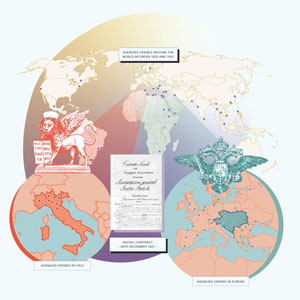The legend of the lion of St. Mark and the eagle that flew away

Legend has it that on a festive evening in a Venetian villa in Predazzi di Asolo, belonging to Senator Giovanni Falier, there was an emergency in the kitchens – a servant had dropped the Murano glass sculpture that was customarily placed as an ornament on top of the cake. The housekeeper had a brainwave and sent for a ten-year-old boy, the grandson of a stonemason, who was already making a name for himself. As soon as he arrived in the kitchen, the boy took a block of butter and moulded it into the shape of a splendid lion. Placed on the cake, the lion was such a success in the dining room that it led the owner of the house, impressed by the boy’s skill, to take care of his education and training. The boy’s name was Antonio Canova, and that lion would bring him great good fortune.
According to animal symbology, the lion is linked to the sun and is synonymous with royalty and wisdom, but a winged lion with one paw on an open book immediately brings two things to mind: Venice and Generali.
This has not always been the case: until the mid-nineteenth century, Generali’s logo was a double-headed eagle, a privilege granted with the Sovereign Resolution of January 25th, 1833. However, after the revolutionary uprisings of 1848, things changed: the company removed the adjective “Austro-Italiche” from its name, and the Venetian Office adopted the lion as its identifying symbol in the territories in which it operated.
“Pax tibi Marce, evangelista meus” – “Peace be with you, Mark, my evangelist” – these words, according to a legend, were uttered by an angel who appeared to St. Mark in a dream, after landing on an island in the Venetian lagoon, and they seem to mean that the saint would find rest, devotion, and honour among the Venetian population. They are written on the book held open by the paw of the winged lion, the symbol of the Evangelist, in the coat of arms of the Republic of Venice, and form the city’s motto.
Since 1260 St. Mark, depicted with his symbol, the winged lion, has been the emblem of the city, chosen by the Republic of Venice.
The lion thus assumed political and religious significance, expressing power and majesty, but also symbolising the power of the Saint’s word, spiritual elevation thanks to its wings, wisdom thanks to the book under its paw, and justice through the presence of the sword.
For the company, changing its symbol from the eagle to the lion meant expanding its horizons and, above all, crossing those borders that separated Italy from Austria.
The name Mark – or its Italian version, Marco – comes up again in this tale and in the life of Generali, because another Marco was involved in writing the company’s history. Born in Trieste in 1843 to a Jewish family of merchants, his organisational skills led him to a rapidly advancing career in the company, from the management of various branches to the Chairmanship in 1909. His name was Marco Besso.
Originally hired as inspector general and legal representative, Besso worked in Milan, Palermo, Bologna, and Florence, and then abroad, before taking on management roles, and becoming Secretary General in Trieste in 1877. In his autobiography, he wrote the following about feeling Italian:
“My feelings, however, were well-known because, naturally, I defended Italian nationality, always on legal grounds; so much so that, especially in recent years, when I had reason to go to Vienna, for our affairs or those of the Insurance Company, the department head of the Ministry of the Interior – on which, for political reasons, all the companies depended indiscriminately – addressed me in Italian: ‘Here’s our irredentist!’.”
HISTORY
Generali has a particular aptitude for openness and internationalisation, and has always proved able to unite interests, places, and people, as the choice of name, Assicurazioni Generali Austro-Italiche, expresses nicely. From the beginning, the goal was to serve both the Habsburg Empire and the Italian states. Indeed, the plan was to hinge the entire organisational, social, and financial structure of the company on two main pillars: the Head Office in Trieste, in charge of running the Habsburg and foreign territories , and the Venetian Office in Venice, responsible for business in Lombardy-Venetia and the rest of the Italian peninsula. The Central European setting in which Generali emerged was extremely advantageous both for expansion in Europe and around the world and for the insurance business itself.
In the early 1880s, Generali had become so widespread geographically that a new organisational strategy was required: it was decided that affiliated companies would be established, sometimes specialising in certain areas of the business, gradually assuming the then-uncommon appearance of a “group”.
